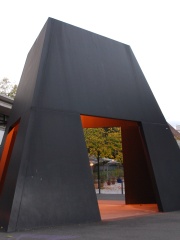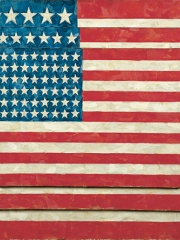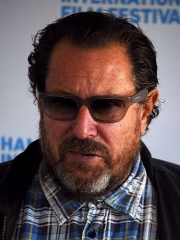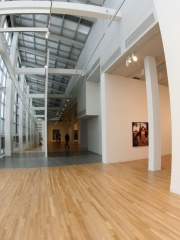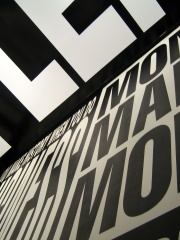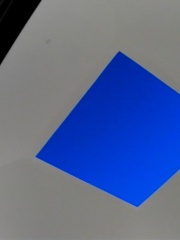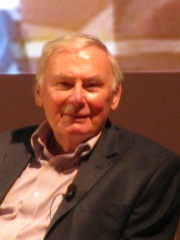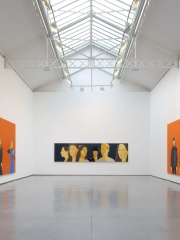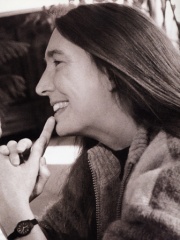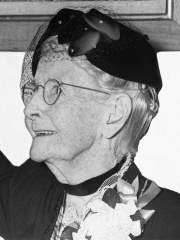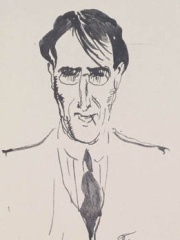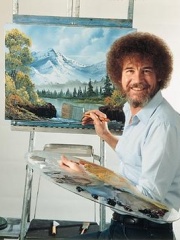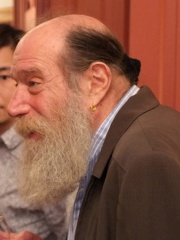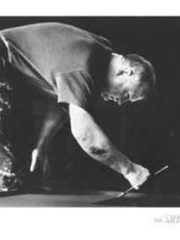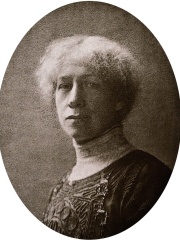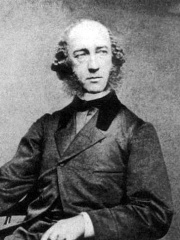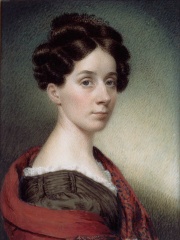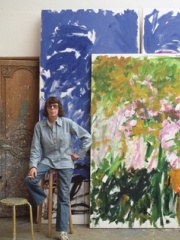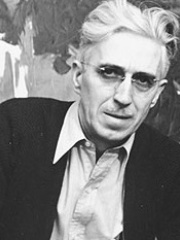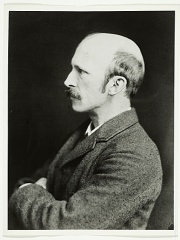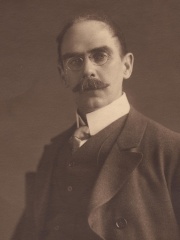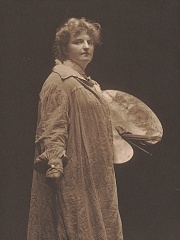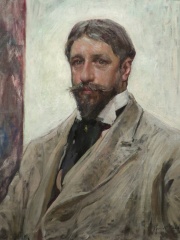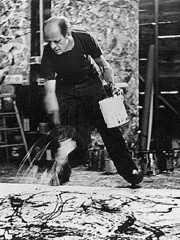
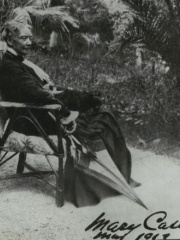
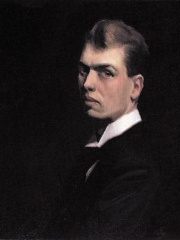
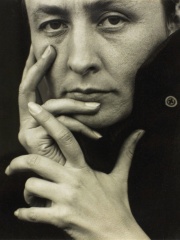
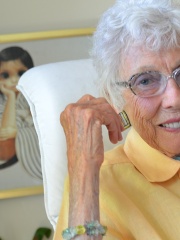
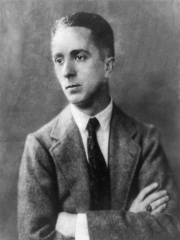
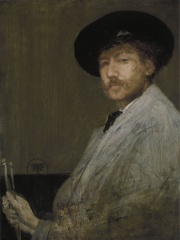
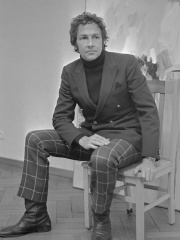
The Most Famous
PAINTERS from United States
This page contains a list of the greatest American Painters. The pantheon dataset contains 1,421 Painters, 142 of which were born in United States. This makes United States the birth place of the 3rd most number of Painters behind Italy and France.
Top 10
The following people are considered by Pantheon to be the top 10 most legendary American Painters of all time. This list of famous American Painters is sorted by HPI (Historical Popularity Index), a metric that aggregates information on a biography’s online popularity. Visit the rankings page to view the entire list of American Painters.

1. Jackson Pollock (1912 - 1956)
With an HPI of 74.57, Jackson Pollock is the most famous American Painter. His biography has been translated into 94 different languages on wikipedia.
Paul Jackson Pollock (; January 28, 1912 – August 11, 1956) was an American painter. A major figure in the abstract expressionist movement, Pollock was widely noticed for his "drip technique" of pouring or splashing liquid household paint onto a horizontal surface, enabling him to view and paint his canvases from all angles. It was called all-over painting and action painting, since he covered the entire canvas and used the force of his whole body to paint, often in a frenetic dancing style. This extreme form of abstraction divided the critics: some praised the immediacy of the creation, while others derided the random effects. A reclusive and volatile personality, Pollock struggled with alcoholism for most of his life. In 1945, he married the artist Lee Krasner, who became an important influence on his career and on his legacy. Pollock died at age 44 in an alcohol-related single-car collision when he was driving. In December 1956, four months after his death, Pollock was given a memorial retrospective exhibition at the Museum of Modern Art (MoMA) in New York City. A larger, more comprehensive exhibition of his work was held there in 1967. In 1998 and 1999, his work was honored with large-scale retrospective exhibitions at MoMA and at the Tate in London.

2. Mary Cassatt (1844 - 1926)
With an HPI of 69.97, Mary Cassatt is the 2nd most famous American Painter. Her biography has been translated into 72 different languages.
Mary Stevenson Cassatt (; May 22, 1844 – June 14, 1926) was an American painter and printmaker. She was born in Allegheny, Pennsylvania (now part of Pittsburgh's North Side), and lived much of her adult life in France, where she befriended Edgar Degas and exhibited with the Impressionists. Cassatt often created images of the social and private lives of women, with particular emphasis on the intimate bonds between mothers and children. She was described by Gustave Geffroy as one of "les trois grandes dames" (the three great ladies) of Impressionism alongside Marie Bracquemond and Berthe Morisot. In 1879, Diego Martelli compared her to Degas, as they both sought to depict movement, light, and design in the most modern sense.

3. Edward Hopper (1882 - 1967)
With an HPI of 69.39, Edward Hopper is the 3rd most famous American Painter. His biography has been translated into 47 different languages.
Edward Hopper (July 22, 1882 – May 15, 1967) was an American realist painter and printmaker. He is one of America's most renowned artists and known for his skill in capturing American life and landscapes through his art. Born in Nyack, New York, to a middle-class family, Hopper's early exposure to art was nurtured by his parents. He studied at the New York School of Art under William Merritt Chase and Robert Henri, where he developed his signature style, characterized by its emphasis on solitude, light, and shadow. Hopper's work, spanning oil paintings, watercolors, and etchings, predominantly explores themes of loneliness and isolation within American urban and rural settings. His most famous painting, "Nighthawks" (1942), epitomizes his interest in the quiet, introspective moments of everyday life. Despite a slow start, Hopper achieved significant recognition by the 1920s, with his work becoming a staple in major American museums. Hopper's technique, marked by a composition of form and use of light to evoke mood, has been influential in the art world and popular culture. His paintings, often set in the architectural landscapes of New York or the serene environments of New England, convey a sense of narrative depth and emotional resonance, making him a pivotal figure in American Realism. Hopper created subdued drama out of commonplace subjects layered with a poetic meaning, inviting narrative interpretations. He was praised for "complete verity" in the America he portrayed. In 1924, Hopper married Josephine Nivison, also an artist, who played a crucial role in managing his career and served as the model for many of his figures. The couple lived a modest life in New York City, with summers spent in Cape Cod, which influenced much of Hopper's later work. Despite his success, Hopper remained a private and introspective individual, dedicated to exploring the subtleties of human experience and the American landscape. His depiction of the American scene, with its emphasis on isolation and contemplation, remains a defining aspect of his appeal and significance in the history of American art.

4. Georgia O'Keeffe (1887 - 1986)
With an HPI of 69.39, Georgia O'Keeffe is the 4th most famous American Painter. Her biography has been translated into 73 different languages.
Georgia Totto O'Keeffe (November 15, 1887 – March 6, 1986) was an American modernist painter and draftswoman whose career spanned seven decades and whose work remained largely independent of major art movements. Called the "Mother of American modernism", O'Keeffe gained international recognition for her meticulous paintings of natural forms, particularly flowers and desert-inspired landscapes, which were often drawn from and related to places and environments in which she lived. From 1905, when O'Keeffe began her studies at the School of the Art Institute of Chicago, until about 1920, she studied art or earned money as a commercial illustrator or a teacher to pay for further education. Influenced by Arthur Wesley Dow, O'Keeffe began to develop her unique style beginning with her watercolors from her studies at the University of Virginia and more dramatically in the charcoal drawings that she produced in 1915 that led to total abstraction. Alfred Stieglitz, an art dealer and photographer, held an exhibit of her works in 1917. Over the next couple of years, she taught and continued her studies at the Teachers College, Columbia University. She moved to New York in 1918 at Stieglitz's request and began working seriously as an artist. They developed a professional and personal relationship that led to their marriage on December 11, 1924. O'Keeffe created many forms of abstract art, including close-ups of flowers, such as the Red Canna paintings, that many found to represent vulvas, though O'Keeffe consistently denied that intention. The imputation of the depiction of women's sexuality was also fueled by explicit and sensuous photographs of O'Keeffe that Stieglitz had taken and exhibited. O'Keeffe and Stieglitz lived together in New York until 1929, when O'Keeffe began spending part of the year in the Southwest, which served as inspiration for her paintings of New Mexico landscapes and images of animal skulls, such as Cow's Skull: Red, White, and Blue (1931) and Summer Days (1936). After Stieglitz's death in 1946, she lived in New Mexico for the next 40 years at her home and studio or Ghost Ranch summer home in Abiquiú, and in the last years of her life, in Santa Fe. In 2014, O'Keeffe's 1932 painting Jimson Weed/White Flower No. 1 sold for $44,405,000—at the time, by far the largest price paid for any painting by a female artist. Her works are in the collections of several museums, and following her death, the Georgia O'Keeffe Museum was established in Santa Fe.

5. Man Ray (1890 - 1976)
With an HPI of 68.84, Man Ray is the 5th most famous American Painter. His biography has been translated into 59 different languages.
Man Ray (born Emmanuel Radnitzky; August 27, 1890 – November 18, 1976) was an American visual artist who spent most of his career in Paris. He was a significant contributor to the Dada and Surrealist movements, although his ties to each were informal. He produced major works in a variety of media but considered himself a painter above all. He was best known for his pioneering photography, and was a renowned fashion and portrait photographer. He is also noted for his work with photograms, which he called "rayographs" in reference to himself.

6. Margaret Keane (1927 - 2022)
With an HPI of 65.91, Margaret Keane is the 6th most famous American Painter. Her biography has been translated into 25 different languages.
Margaret D. H. Keane (born Peggy Doris Hawkins, September 15, 1927 – June 26, 2022) was an American artist known for her paintings of subjects with big eyes. She mainly painted women, children, or animals in oil or mixed media. The work achieved commercial success through inexpensive reproductions on prints, plates, and cups. It has been critically acclaimed but also criticized as formulaic and cliché. The artwork was originally attributed to Keane's then-husband, Walter Keane. Soon after their divorce in the 1960s, Margaret claimed credit, which was established after a court "paint-off" in Hawaii. A resurgence of interest in Margaret Keane's work followed the release of Tim Burton's 2014 biopic Big Eyes. She maintained a gallery in San Francisco which boasts "the largest collection of Margaret Keane's art in the entire world." In light of the great gulf between her work's popularity and its critical lampooning, she was sometimes referred to as the "Wayne Newton of the art world."

7. Norman Rockwell (1894 - 1978)
With an HPI of 63.17, Norman Rockwell is the 7th most famous American Painter. His biography has been translated into 44 different languages.
Norman Percevel Rockwell (February 3, 1894 – November 8, 1978) was an American painter and illustrator. His works have a broad popular appeal in the United States for their reflection of the country's culture. Rockwell is most famous for the cover illustrations of everyday life he created for The Saturday Evening Post magazine over nearly five decades. Among the best-known of Rockwell's works are the Willie Gillis series, Rosie the Riveter, The Problem We All Live With, Saying Grace, and the Four Freedoms series. He is also noted for his 64-year relationship with the Boy Scouts of America (BSA), during which he produced covers for their publication Boys' Life (now Scout Life), calendars, and other illustrations. These works include popular images that reflect the Scout Oath and Scout Law such as The Scoutmaster, A Scout Is Reverent, and A Guiding Hand. Rockwell was a prolific artist, producing more than 4,000 original works in his lifetime. Most of his surviving works are in public collections. Rockwell was also commissioned to illustrate more than 40 books, including Tom Sawyer and Huckleberry Finn and to paint portraits of Presidents Eisenhower, Kennedy, Johnson, and Nixon, as well as those of foreign figures, including Gamal Abdel Nasser and Jawaharlal Nehru. His portrait subjects also included Judy Garland. One of his last portraits was of Colonel Sanders in 1973. His annual contributions for the Boy Scouts calendars between 1925 and 1976 (Rockwell was a 1939 recipient of the Silver Buffalo Award, the highest adult award given by the Boy Scouts of America), were only slightly overshadowed by his most popular of calendar works: the "Four Seasons" illustrations for Brown & Bigelow that were published for 17 years beginning in 1947 and reproduced in various styles and sizes since 1964. He created artwork for advertisements for Coca-Cola, Jell-O, General Motors, Scott Tissue, and other companies. Illustrations for booklets, catalogs, posters (particularly movie promotions), sheet music, stamps, playing cards, and murals (including "Yankee Doodle Dandy" and "God Bless the Hills", which was completed in 1936 for the Nassau Inn in Princeton, New Jersey) rounded out Rockwell's oeuvre as an illustrator. Rockwell's work was dismissed by serious art critics in his lifetime. Many of his works appear overly sweet in the opinion of modern critics, especially the Saturday Evening Post covers, which tend toward idealistic or sentimentalized portrayals of American life. This has led to the often deprecatory adjective "Rockwellesque". Consequently, Rockwell is not considered a "serious painter" by some contemporary artists, who regard his work as bourgeois and kitsch. Writer Vladimir Nabokov stated that Rockwell's brilliant technique was put to "banal" use, and wrote in his novel Pnin: "That Dalí is really Norman Rockwell's twin brother kidnaped by gypsies in babyhood." He is called an "illustrator" instead of an artist by some critics, a designation he did not mind, as that was what he called himself. In his later years, Rockwell began receiving more attention as a painter when he chose more serious subjects such as the series on racism for Look magazine. One example of this more serious work is The Problem We All Live With, which dealt with the issue of school racial integration. The painting depicts Ruby Bridges, flanked by white federal marshals, walking to school past a wall defaced by racist graffiti. This 1964 painting was displayed in the White House when Bridges met with President Barack Obama in 2011.

8. James Abbott McNeill Whistler (1834 - 1903)
With an HPI of 61.95, James Abbott McNeill Whistler is the 8th most famous American Painter. His biography has been translated into 51 different languages.
James Abbott McNeill Whistler (; July 10, 1834 – July 17, 1903) was an American painter in oils and watercolor, and printmaker, active during the American Gilded Age and based primarily in the United Kingdom. He eschewed sentimentality and moral allusion in painting and was a leading proponent of the credo "art for art's sake". His signature for his paintings took the shape of a stylized butterfly with an added long stinger for a tail. The symbol combined both aspects of his personality: his art is marked by a subtle delicacy, while his public persona was combative. He found a parallel between painting and music, and entitled many of his paintings "arrangements", "harmonies", and "nocturnes", emphasizing the primacy of tonal harmony. His most famous painting, Arrangement in Grey and Black No. 1 (1871), commonly known as Whistler's Mother, is a revered and often parodied portrait of motherhood. Whistler influenced the art world and the broader culture of his time with his aesthetic theories and his friendships with other leading artists and writers.

9. Robert Rauschenberg (1925 - 2008)
With an HPI of 60.56, Robert Rauschenberg is the 9th most famous American Painter. His biography has been translated into 38 different languages.
Milton Ernest "Robert" Rauschenberg (October 22, 1925 – May 12, 2008) was an American painter and graphic artist whose early works anticipated the Pop art movement. Rauschenberg is well known for his Combines (1954–1964), a group of artworks which incorporated everyday objects as art materials and which blurred the distinctions between painting and sculpture. Rauschenberg was primarily a painter and a sculptor, but he also worked with photography, printmaking, papermaking and performance. Rauschenberg received numerous awards during his nearly 60-year artistic career. Among the most prominent were the International Grand Prize in Painting at the 32nd Venice Biennale in 1964 and the National Medal of Arts in 1993. Rauschenberg lived and worked in New York City and on Captiva Island, Florida, until his death on May 12, 2008.
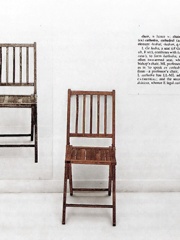
10. Joseph Kosuth (1945 - )
With an HPI of 60.51, Joseph Kosuth is the 10th most famous American Painter. His biography has been translated into 29 different languages.
Joseph Kosuth (; born January 31, 1945) is an American conceptual artist, who lives in New York and London, after having resided in various cities in Europe, including Ghent and Rome.
Pantheon has 142 people classified as painters born between 1250 and 1977. Of these 142, 19 (13.38%) of them are still alive today. The most famous living painters include Joseph Kosuth, Bruce Nauman, and Frank Stella. The most famous deceased painters include Jackson Pollock, Mary Cassatt, and Edward Hopper. As of April 2022, 29 new painters have been added to Pantheon including Lawrence Weiner, Ad Reinhardt, and Anna Elizabeth Klumpke.
Living Painters
Go to all Rankings
Joseph Kosuth
1945 - Present
HPI: 60.51
Bruce Nauman
1941 - Present
HPI: 59.00
Frank Stella
1936 - Present
HPI: 58.69
Richard Serra
1939 - Present
HPI: 58.60
Jasper Johns
1930 - Present
HPI: 55.80
Julian Schnabel
1951 - Present
HPI: 55.49
Cindy Sherman
1954 - Present
HPI: 54.83
Barbara Kruger
1945 - Present
HPI: 53.03
James Turrell
1943 - Present
HPI: 51.81
Richard Estes
1932 - Present
HPI: 48.94
Alex Katz
1927 - Present
HPI: 47.64
Jenny Holzer
1950 - Present
HPI: 47.50

Deceased Painters
Go to all Rankings
Jackson Pollock
1912 - 1956
HPI: 74.57
Mary Cassatt
1844 - 1926
HPI: 69.97
Edward Hopper
1882 - 1967
HPI: 69.39
Georgia O'Keeffe
1887 - 1986
HPI: 69.39
Man Ray
1890 - 1976
HPI: 68.84
Margaret Keane
1927 - 2022
HPI: 65.91
Norman Rockwell
1894 - 1978
HPI: 63.17
James Abbott McNeill Whistler
1834 - 1903
HPI: 61.95
Robert Rauschenberg
1925 - 2008
HPI: 60.56
Grandma Moses
1860 - 1961
HPI: 60.43
Lyonel Feininger
1871 - 1956
HPI: 60.26
Bob Ross
1942 - 1995
HPI: 59.80

Newly Added Painters (2022)
Go to all Rankings
Lawrence Weiner
1942 - 2021
HPI: 53.01
Ad Reinhardt
1913 - 1967
HPI: 51.76
Anna Elizabeth Klumpke
1856 - 1942
HPI: 51.06
Martin Johnson Heade
1819 - 1904
HPI: 49.01
Sarah Goodridge
1788 - 1853
HPI: 48.27
Morris Louis
1912 - 1962
HPI: 47.57
Joan Mitchell
1925 - 1992
HPI: 46.79
Clyfford Still
1904 - 1980
HPI: 46.10
Abbott Handerson Thayer
1849 - 1921
HPI: 45.09
Colin Campbell Cooper
1856 - 1937
HPI: 44.94
Katherine Sophie Dreier
1877 - 1952
HPI: 44.01
Robert Reid
1862 - 1929
HPI: 43.81

Which Painters were alive at the same time? This visualization shows the lifespans of the 25 most globally memorable Painters since 1700.

